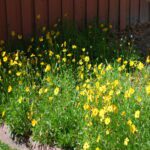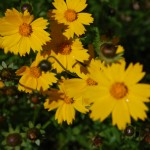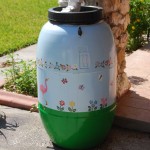
Before we get started on the remaining reasons to plant native and wildflowers, let’s talk about the Florida State Wildflower. The Coreopsis lanceolate, or better known as “Tick Seed.” This lance leaf coreopsis is a vibrant yellow wildflower that will grow to 2 feet tall. It is a perennial and blooms in the spring, summer, and fall. There are 13 native coreopsis wildflower species to choose from and no garden should be without them (see picture provided). What’s even better, every year your bouquet of blooms will grow bigger and brighter, they multiply and divide.
Now, the remaining reasons you have all been waiting for:
6. Manage Yard Pests Responsibly
Nature will take care of itself. Use pesticides wisely. Misuse of pesticides can filter into our waterways and is harmful to the good insects that protect your yard. Spot check the lawn and only use pesticides in areas as needed.
7. Recycle
Don’t’ get me started on recycling. Mow the lawn without the bag, let those grass clippings help provide nutrients for the lawn and reduce waste disposal. Or take the grass clippings, leaves and yard trimmings then compost and recycle as much as possible.
8. Reduce Storm Water Runoff
I suppose asking everyone to have a rain barrel on every corner of your house would be asking too much. Unfortunately running water can be very harmful to our water supply. The runoff carries pollutants, such as fertilizer, pesticides, soil and debris which are harmful to our water quality. Adding a rain barrel, gutters that divert the water to areas of your lawn that need it most and limiting the use of fertilizer and pesticides will definitely made a difference.

9. Protect the Waterfront
Waterfront property, it doesn’t matter if it’s beachfront, river front, steams or ponds, there is a very fragile ecosystem going on there and it is your responsibility to protect it. Always keep the fertilizer and pesticides 10-30 feet from the shore line. A no-maintenance “ring of responsibility” of at least 10 feet around the shoreline of ponds, lakes, rivers and streams assures you that no fertilizers or pesticides are applied too close to the water line.
Visit www.floridayards.org for more information and learn more about at the 9 reasons to use Florida friendly plants and wildflowers.
Just a few additional tips to help you conserve water and save time and money:
*Water only when necessary, you know when your lawn looks stressed and thirsty.
*A rain gauge or moisture sensor is a small but great investment and helps you know if the rainfall is sufficient to maintain a healthy lawn.
*Install a drip or micro spray system in your flower beds. It’s much more efficient.
*Stop over watering, we all do it. It does more harm than good.
*Get to know your yard. It’s important that you know what type of soil you have, where “the sun shines in” and the shade is darkest. But most of all where there is plenty of water and where there’s not. Once you understand the conditions of your yard then you, with help from your landscaper or lawn and garden center, can pick the right plants for the right spot.
*Keep grass useful. If you must have grass – of course you must- make sure it is a drought tolerant variety. If not, try to replace it with one that is or replace the lawn with drought tolerant plants. When adding that grass feature to your lawn make sure the areas designated will be functional and easy to maintain plus it provides a good filter for storm water runoff. This is a major way to conserve water and keep that utility bill from going through the roof.

*Invest in a rain barrel, collecting rain water is the best way to water your plants, indoors and out. Oops I said it again.
*Avoid invasive – welcome wildlife. Can’t stress enough the importance of knowing what is bad for your yard. Introducing invasive plants into your landscape is a big NO, NO. These plants take over and other plants in your garden suffer and die. If you have Laurel Fig, Japanese honeysuckle or woman’s tongue, just to name a few, get rid of it. Remove it and replace it with Florida Friendly plants and flowers. When the living conditions are right the wildlife will move right in.
I am a big believer; use Florida natives and Florida wildflowers in your landscape. It’s even okay to mix and match with some that are not native to Florida. You will not only be providing you and your neighbors something wonderful to look at but, most of all, you will be contributing to the ecosystem and making sure our fabulous state maintains it natural beauty with plants and flowers that live and thrive in Florida.
If you missed the 2010 Florida Wildflower and Garden Festival this year in Deland, Florida, that’s a shame. But, the good new is it will be back next year. Until then, I expect to see you all there in 2011.
This is Elaine and let the sun shine in.
Elaine Huffman
Author, Publisher, and Environmentally Conscious


